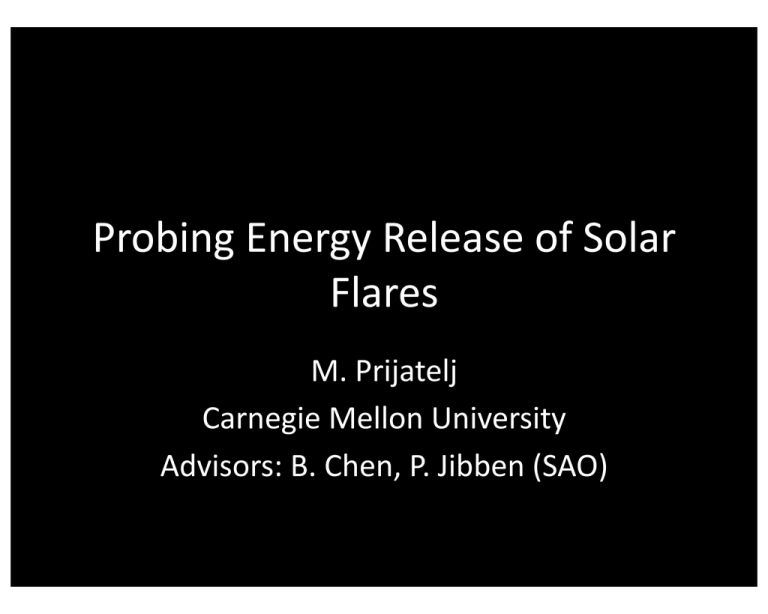2f p - Zenodo
advertisement

Probing Energy Release of Solar Flares M. Prijatelj Carnegie Mellon University Advisors: B. Chen, P. Jibben (SAO) Overview • MoEvaEons • Standard Flare Model – Flux rope erupEon – MagneEc reconnecEon – Flare emissions • Type III Radio Bursts • Instruments – VLA, AIA, HMI, & RHESSI • Observed Flare • Dynamic Imaging Spectroscopy • Results & Conclusions 2 MoEvaEons • InvesEgate basic solar flare physics – Energy release, parEcle acceleraEon & transportaEon • Understand flares’ cause and impact – Analyzing flare parEcles • Map reconnected coronal magneEc field lines – Dynamic Imaging Spectroscopy Figure 1: AIA image of the sun, wavelength 171Å 3 Standard Flare Model • Flux rope erupEon • MagneEc reconnecEon • Flare emissions Figure 2: Large solar filament erupEon h\p://www.nasa.gov/images/content/683943main_erupEon-­‐zoom.jpg 4 Flux Rope ErupEon • Flux ropes form within solar atmosphere • Flux rope loses equilibrium & erupts – Magnetohydrodynamic (MHD) instabiliEes – MagneEc reconnecEons • Field lines reconnect following erupEon Figure 3: Diagram of erupEon & magneEc reconnecEon h\p://solarmuri.ssl.berkeley.edu/~hhudson/cartoons/thepages/Shibata.html 5 MagneEc ReconnecEon • Inwardly moving anEparallel field lines connect • Reconnected lines flow outward • MagneEc energy release – Thermal energy – KineEc energy • ParEcle acceleraEon • Bulk moEon Figure 4: AnimaEon of anEparallel magneEc field lines undergoing magneEc reconnecEon h\ps://upload.wikimedia.org/wikipedia/commons/2/24/ReconnecEon.gif 6 Flare Emissions RADIO BURSTS Figure 5: RadiaEon emissions generated by magneEc reconnecEon h\p://solarmuri.ssl.berkeley.edu/~hhudson/cartoons/thepages/Svestka.html 7 – Generate Langmuir waves near plasma frequency fp – Emit radio bursts near fp or 2fp • Electron beam direcEon affects burst drij direcEon – Upward ! NegaEve – Downward ! PosiEve Frequency • Created by flare-­‐ accelerated electrons Downward Upward Type III Radio Bursts Chromosphere Time Figure 6: Trajectories of electron beams (green) from reconnecEon site (red X) along magneEc field lines (blue) with respect to frequency drijs. 8 Imaging Instruments • Karl G. Jansky Very Large Array (VLA): Radio wavelengths • Atmospheric Imaging Assembly (AIA): Extreme ultraviolet • Helioseismic & MagneEc Imager (HMI): MagneEc field • Reuven Ramaty High Energy Solar Spectroscope Imager (RHESSI): Soj & hard X-­‐ray, gamma rays 9 VLA Data • Broadband dynamic imaging spectroscopy – Large instantaneous bandwidth – High temporal resoluEon – High spectral resoluEon – Full Fourier synthesis imaging • Dynamic Spectrum & Imaging Figure 7: SpaEal imaging of a type III radio burst. 10 AIA, HMI, & RHESSI • AIA images solar chromosphere & corona – Seven extreme ultraviolet (EUV) channels • HMI photospheric magneEc field measurements – White posiEve (outward) polarity – Black negaEve (inward) polarity • RHESSI images soj X-­‐rays to gamma rays – X-­‐rays primarily emi\ed by accelerated electrons Figure 8: Data of C7.2 flare in various wavelengths (clockwise from top lej): AIA 171 Å, HMI line-­‐of-­‐sight magnetogram, RHESSI HXR data 11 Observed Solar Flare • C7.2 solar flare • Observed Nov. 1, 2014 • Impulsive phase of the flare – Interested in type III radio bursts Figure 9: GOES X-­‐ray flux data at Eme of C7.2 flare, 2014-­‐11-­‐01, impulsive phase highlighted h\p://www.polarlicht-­‐vorhersage.de/goes/2014-­‐11-­‐01_163500_2014-­‐11-­‐01_172600.png 12 Dynamic Imaging Spectroscopy Leading Edge Figure 10: Dynamic spectrum during C7.2 flare, with closer inspecEon of a negaEvely-­‐drijing type III burst, indicaEng an upward-­‐moving electron beam, and a spaEal image of the radio burst. 13 AIA Movie of C7.2 Flare Figure 11: AIA 171 Å movie of C7.2 solar flare at 16:37:04 on 2014-­‐11-­‐01 14 AIA & HMI Comparison 16:35:00.340 16:42:48.340 Flare Ribbons 17:10:00.340 Post-­‐Flare Loops Flux Rope Flux Rope Sigmoid Figure 12: AIA 171 Å images before, during, and ajer the solar flare. HMI posiEve (white) & negaEve (black) polar regions are contoured. 15 Results & Conclusions • Findings correspond with standard flare model Flare Ribbons – ReconnecEon region trails erupEng flux rope (AIA) – Electron beams follow reconnected field lines • Downward beams create HXR footpoints • Type III bursts from upward & downward beams Flux Rope HXR Emissions Radio Frequency Maxima Figure 13: AIA 171 Å flare image with overlaid VLA radio emission maxima & single flux contour (colored dots & blue contour, respecEvely), HMI contours (posiEve regions white, negaEve regions black), and RHESSI contours (red contours). The magneEc field lines are purple lines, the “X-­‐point” is at the yellow explosion, & the electron beam trajectories are blue arrows. 16 Summary • VLA indirectly maps reconnected magneEc fields – Radio emissions determine electron beam trajectories – Trajectories follow reconnected field lines • AIA, HMI, & RHESSI provide addiEonal context • Data juxtaposiEon demonstrates standard flare model 17 Acknowledgements • NSF-­‐REU solar physics program at SAO, grant number AGS-­‐1263241 • NASA contract SP02H1701R from Lockheed-­‐MarEn to SAO 18 Special Thanks To • Henry “ Trae” Winter & Kathy Reeves • Bin Chen & Patricia Jibben • Everyone else at Harvard CfA & SAO 19 AddiEonal InformaEon • AIA images solar chromosphere & corona – – – – – EnEre solar disk Seven extreme ultraviolet (EUV) channels Temperature range from 20 000K to 20 000 000 K 12 second cadence 1.5 arcsec resoluEon • Field lines flow posiEve to negaEve – “Footpoints” – Plasma flow along field lines • RHESSI: – X-­‐rays typically emi\ed at footpoint • Accelerated electrons collide with chromosphere 20



